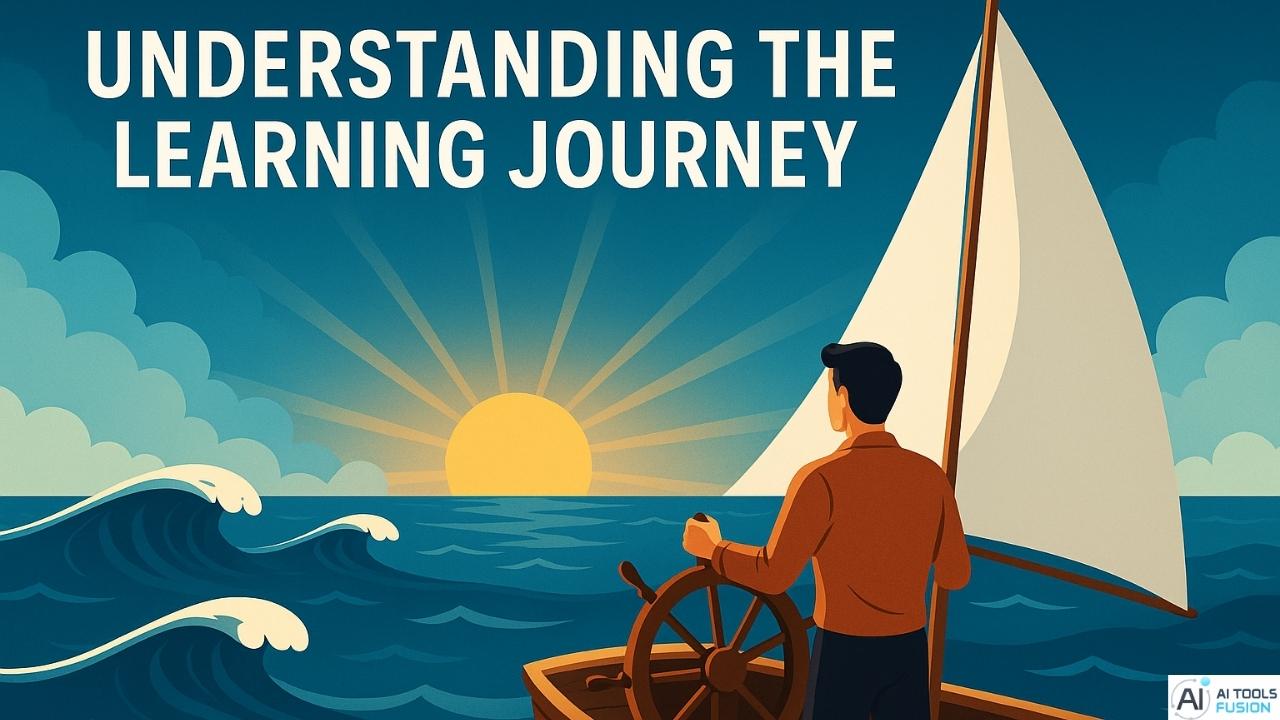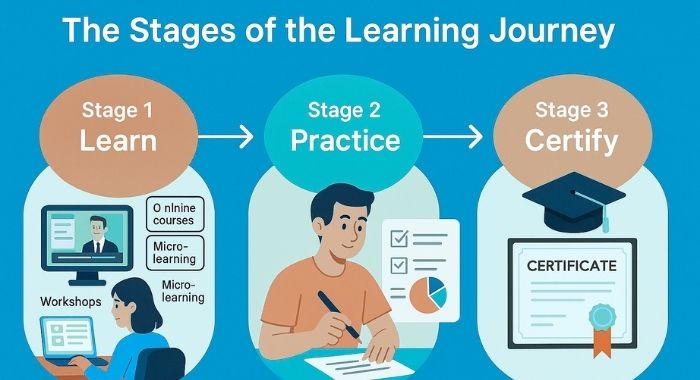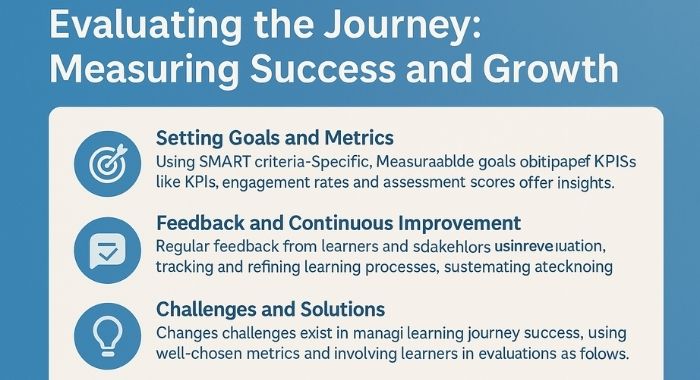Start Your Learning Journey with Purpose and Passion

Embarking on a learning journey is akin to navigating the vast expanse of uncharted waters, where each wave represents a new concept to master, and every horizon unveils growth potential. A learning journey is not merely the acquisition of knowledge; it is a transformative process that fosters intellectual curiosity, resilience, and adaptability. For educators, learners, and lifelong enthusiasts, understanding the fundamentals of this journey is crucial. It encompasses setting goals, leveraging resources, and engaging in reflective practices that enrich the learning experience. This exploration seeks to unravel the intricate layers of learning journeys, offering insights into their profound impact on personal and professional development.
Table of Contents
What Is a Learning Journey?
Definition and Purpose
A learning journey refers to the systematic process individuals or organizations undertake to acquire new knowledge and competencies. This transformative experience is not just about the destination, but rather about the continuous movement through stages of understanding, skill development, and personal growth. Through these journeys, learners traverse from a state of novice to expert, embracing challenges and reflecting on experiences to build a profound comprehension of their field.
Components of a Learning Journey
The essence of a learning journey lies in its well-structured path, often comprising several integral components:
- Goal Setting: Establishing clear, achievable objectives to guide the learner’s direction.
- Resource Identification: Sourcing appropriate materials and tools to support learning.
- Reflection and Assessment: Continuously evaluating progress and adapting strategies to ensure effective learning.
The Significance
Engaging in a learning journey is crucial in today’s dynamic world, where knowledge is a powerful currency. It empowers individuals to stay relevant and competent, fostering a culture of lifelong learning and continuous improvement.
The Stages of the Learning Journey

Stage 1: Learn
The first stage of the learning journey involves the acquisition of knowledge. Here, learners immerse themselves in understanding fundamental concepts through varied formats such as online courses, workshops, and micro-learning sessions. This stage also emphasizes the implementation of strategies like spaced learning to enhance retention. Learners are encouraged to adopt personalized pathways that cater to their unique needs, ensuring an optimally engaging experience.
Stage 2: Practice
After acquiring foundational knowledge, the learning journey transitions into the practice stage. This phase focuses on reinforcing learned skills through practical application. Learners engage with practice questions, self-assessments, and mock exams to solidify their understanding and boost confidence. Effective practice not only prepares individuals for examinations but also allows them to recognize their strengths and areas for improvement.
Stage 3: Certify
The final stage is marked by certification, where learners validate their proficiency through formal exams. Achieving certification not only enhances credibility but also opens doors to better career prospects by standing out in the competitive job market. Once certified, learners cycle back to the ‘Learn’ stage, embracing continuous learning to refine existing skills or acquire new ones, thus perpetuating their lifelong learning journey.
Developing the Learning Journey: Formal and Informal Learning
Building a Comprehensive Strategy
In a modern organizational learning journey, constructing a balanced strategy that incorporates both formal and informal learning is crucial. Formal learning is structured and typically involves mandatory programs such as onboarding and compliance training. These programs provide a foundational knowledge critical to business operations and can be delivered through online platforms or face-to-face sessions, which are notably trackable and measurable through platforms like an LMS.
On the other hand, informal learning is self-directed and takes place in more flexible environments. It happens naturally through peer interactions, independent research, and access to resources that foster creativity and collaboration. While not as easily quantifiable as its formal counterpart, informal learning plays an essential role in embracing a holistic approach, encouraging employees to engage in a sustainable development culture. Organizations must strive to seamlessly blend these methods, ensuring that formal training establishes the groundwork, while informal learning fosters continuous growth and adaptability.
How to Write a Learning Journey
Define Objectives Clearly
Creating a well-structured learning journey begins with setting clear objectives. These objectives form the backbone of the learning process, allowing individuals to focus on what is essential. For instance, a coder might aim to master a specific programming language, guiding their learning efforts towards resources and practice that align with this goal. Documenting objectives ensures learners can measure progress effectively.
Plan the Journey
A successful learning journey requires an organized plan. This involves identifying the steps or milestones needed to achieve the set goals. A well-planned journey includes a timeline, resources to utilize, and checkpoints for assessing progress. By laying out a clear path, learners minimize distractions and maintain motivation.
Document the Process
Documenting each step of the learning journey is crucial for accountability and assessment. Regular documentation helps solidify new knowledge and creates a valuable record that can be referred to later. Utilizing a systematic approach, like taking notes or blogging about daily learnings, ensures continuous engagement and reflection throughout the learning journey.
Step-by‑Step Guide to Crafting Your Own Journey
- Define your learner: List their goals, strengths, challenges.
- Outline stages: e.g., Entry → Skill-building → Validation → Mastery.
- Assign activities: Mix videos, quizzes, assignments, peer work.
- Choose your format: Miro board, PowerPoint roadmap, checklist.
- Add AI touch: Use tools like PlanGlow for adaptive pacing.
- Pilot it: Gather feedback, iterate the layout and checkpoints.
Setting Up Milestones in Your Learning Journey
Identifying Key Milestones
Establishing clear milestones is crucial in a learning journey. These milestones serve as vital checkpoints that signal progress and guide learners toward their ultimate goal. They can range from mastering specific skills to achieving broader educational objectives. By defining these markers, learners are able to celebrate accomplishments that foster motivation and build confidence. As a key component of structured learning experiences, milestones help maintain focus while breaking down complex tasks into manageable segments.
Celebrating Achievements
Recognizing and celebrating educational achievements enhances the learning experience significantly. This can be done through digital portfolios that allow learners to document their progress in a dynamic format. Technologies like AR can create immersive experiences, boosting engagement. Furthermore, sharing successes on social media platforms fosters a supportive community and encourages ongoing commitment to learning.
Enhancing the Experience
Incorporating milestones into courses is beneficial, particularly in structured settings that require a sequential approach to content. Such settings ensure that foundational material is mastered before advancing, maintaining content integrity and promoting optimal outcomes. This is reflected in platforms like BenchPrep, where milestone-based learning paths structure progress effectively as further explained by educational tools.
Core Components of a Learning Journey Template
- Learner personas – Who are they? Novice, career switcher, student?
- Milestones – What’s the journey’s structure? Onboarding, progress check, mastery.
- Activities & touchpoints – Workshops, quizzes, peer sessions, projects.
- Feedback loops – Frequent check-ins, automated AI prompts, peer reviews.
- Tech integration – LMS tools, chatbots, analytics dashboards.
Evaluating the Journey: Measuring Success and Growth

Setting Goals and Metrics
In the realm of education, setting clear, measurable goals is critical for evaluating the success of a learning journey. Utilizing the SMART criteria—Specific, Measurable, Achievable, Relevant, and Time-bound—provides a structured approach to measuring progress. This method ensures learners have a well-defined path, fostering motivation and focus throughout the journey. A variety of Key Performance Indicators (KPIs) such as engagement rates, completion rates, and assessment scores offer insights into learners’ progress in real-time and at completion.
Feedback and Continuous Improvement
Regular feedback is essential for the continuous improvement of a learning journey. Gathering insights from learners, educators, and other stakeholders through surveys or discussions enables instructional designers to make informed adjustments. This aligns with the necessity for formative assessments, which act as checkpoints, and summative assessments that evaluate overall outcomes. Utilizing technology, such as learning management systems, helps track and refine learning processes, bolstering effectiveness and ensuring goals are met.
Challenges and Solutions
Several challenges exist in measuring learning journey success, including defining what success looks like and managing vast amounts of data. These challenges can be effectively tackled by using well-chosen metrics and involving learners directly in the evaluation process. By exploring case studies of successful initiatives, educators can gain valuable insights into overcoming obstacles, highlighting the importance of adaptability and engagement in achieving educational success.
Learning Journey Templates
Structured Pathways
Learning journey templates offer structured pathways that facilitate knowledge acquisition and skill development. These templates serve as visual tools that enable organizations to design, implement, and track learning journeys effectively. They incorporate various elements such as timelines, milestones, progress indicators, and interactive visuals, ensuring a comprehensive approach to the learning process. Through such templates, organizations can align educational objectives with strategic priorities, fostering an environment that supports continuous professional growth.
Customizable and Engaging
Notably, learning journey templates are highly customizable, allowing for adaptations that meet specific organizational needs. This flexibility enhances learner engagement by tailoring the educational experience to individual student personas and defined learning stages. Utilizing these templates can significantly improve information retention and the overall effectiveness of training initiatives, making them invaluable for planning and sharing learning experiences within institutions.
Benefits of Engagement and Retention
Implementing learning journey mapping can boost learner engagement and retention. By visualizing key learning stages and addressing potential pain points, these templates facilitate a seamless learning experience. They enable organizations, especially Registered Training Organizations (RTOs), to comply with regulatory standards while enhancing course delivery and completion rates. Furthermore, integrating support and technology within these maps helps in creating tailored, engaging educational experiences, thus streamlining the learning journey.
AI Integration in Learning Journeys
- PlanGlow: Creates transparent, personalized study plans that students can control and understand.
- SocratiQ: AI companion using Socratic questioning to adapt paths in STEM education.
- Adaptive learning systems: Algorithms tailor content delivery and pace, driving better outcomes.
Learning Journey Examples
Structured Learning Journeys
A structured learning journey is a comprehensive path that guides an individual’s education via planned courses and experiences. Companies often design such journeys to enhance employee skills and drive performance. For instance, organizations like HR departments might begin with onboarding, then assess individual skills to tailor unique learning paths. These may include online modules, interactive workshops, and hands-on tasks. Feedback loops and mentorship are often embedded to ensure continuous development, motivating employees to excel.
Dynamic and Adaptive Learning Environments
Alternatively, dynamic learning journeys focus on flexibility, adapting to the needs of learners over time. In an educational setting, early years’ classrooms might employ an evolving learning display, capturing students’ growth through creative and collaborative exercises. Such environments encourage autonomy, allowing learners to explore topics at their own pace, fostering a sense of ownership and engagement in their learning journey. This approach supports personalized and social learning, fundamental in modern educational strategies.
What Is a Quote About Learning Journeys?
Understanding Quotes on Learning Journeys
Learning journeys are not just a series of educational milestones but a continuous path of growth and exploration. Widely revered quotes serve as guiding lights on these journeys. For instance, Mahatma Gandhi’s profound words, “Live as if you were to die tomorrow, learn as if you were to live forever,” underscore the endless and essential nature of learning. This perspective mirrors the idea that a learning journey is a process without a defined endpoint—a concept that encourages constant curiosity and adaptability.
More than mere acquisition of knowledge, a learning journey involves critical thinking and personal growth. Anthony J. D’Angelo aptly stated, “Develop a passion for learning. If you do, you will never cease to grow,” highlighting that learning fuels both personal and professional development. Thus, quotes about learning journeys inspire individuals to embrace lifelong education with passion and resilience.
Conclusion
In essence, understanding the fundamentals of a learning journey empowers individuals to navigate their personal and professional growth with intention and clarity. By recognizing the dynamic interplay between curiosity, resilience, and reflection, learners can craft experiences that are both enriching and transformative. As educational paradigms continue to evolve, embracing a learning journey mindset allows one to adapt and thrive amidst the ever-changing landscape of knowledge. Ultimately, this journey is not a finite path but a lifelong commitment to exploration and discovery, fostering a culture of continuous improvement and innovation that benefits both the individual and society at large.
See Also: How to Create Marketing Copywriting: An Ultimate Guide